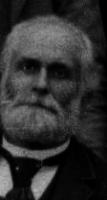
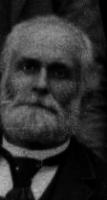
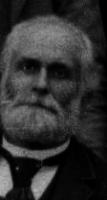 R.I. Knapp, Photo San Mateo County History Museum, Redwood City
R.I. Knapp, Photo San Mateo County History Museum, Redwood City
Legend has it that in the 1870s when the inventive genius Robert Israel (“R.I.”) Knapp moved to the close-knit Coastside, Half Moon Bay had more watering holes than anything else–and saloons were often built next door to the blacksmith’s shop.
By trade, “R.I” was a top-notch blacksmith–but he never stepped inside a saloon. He was a religious man who must have agonized that Half Moon Bay had more saloons than churches. Knapp was a teetoaler who, in addition to his blacksmithing duties, spent his time trying to figure out how to fix things and to make them work more efficiently. Wagons. Carriages. Farming tools.
Knapp knew that Half Moon Bay marked the entrance to the Coastside, and that the rural village held great potential for new business but the place failed to impress outsiders. One traveler said that Half Moon Bay “contains little to attract a stranger,” and an unsympathetic stagecoach passenger observed that he saw “mostly whisky and blacksmiths”.
But in the 1870s, with the United States Geological Survey team preparing reports on California’s abundant natural resources, and the transcontinential railroad connecting the coasts, it was the beginning of an exciting era. There was even talk of a railroad coming to the Coastside, opening up this isolated and beautiful part of the world.
In Half Moon Bay new businesses were opening up– a brewery, hotel and retail stores, including a millinery shop. Local sawmill owners provided lumber for the burgeoning town, and the farmers harvested potatoes and other vegetables, winning blue ribbons for giant heads of lettuce and five-foot-long cucumbers grown in the rich, loamy soil.
Knapp’s repair shop was the hub where the locals gossiped about the booming Coastside and the regulars grew weary of hearing R.I. complain that there were too many saloons.
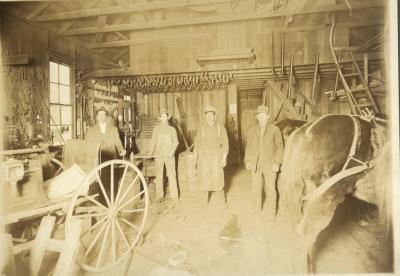 (Photo :Inside a blacksmith’s shop in Half Moon Bay, Spanishtown Historical Society.)
(Photo :Inside a blacksmith’s shop in Half Moon Bay, Spanishtown Historical Society.)
Of concern to the farmers was the Killgore Plow, the only tool available for use on the Coastside’s hilly terrain. They said the plow wasn’t versatile–anything would be an improvement.They complained that “the Easterners”, who manufactured the cursed Killgore Plow, knew nothing about the mountainous coastal terrain. Could R.I. Knapp build a plow to suit their needs?
Knapp tackled the project with passion, coming up with a simple locking device that enable his new lightweight, but sturdy plow to swivel, distributing soil to the right or left, as desired. The new plow, invented in Half Moon Bay, answered every Coastside farmer’s prayer.
A major technological breakthrough, Knapp’s “Side-Hill Plow” increased agricultural productivity and received a patent in 1875. But Knapp didn’t anticipate the plow’s enormous success and he found himself unprepared for the flood of orders that came. He converted his repair shop into a small factory and the first steel plows were fashioned entirely by hand with the steel cut on an anvil. But the orders kept pouring in and it became clear that Knapp better install better labor-saving equipment.
Those who witnessed Knapp’s innovation described with wonder the single-horse on a treadmill powering the machinery. But even this “one-horsepower” machine could not meet the demand for more and more plows as Knapp’s employees worked late into the night to cut into the mountain of orders.
Events would soon severely test Knapp’s spirit. The celebration of New Years 1880 had barely faded from memory when a mass of flames engulfed Knapp’s factory, spreading to Quinlan’s Saloon and burning a stagecoach owned by Taft & Garretson.
Lacking modern day fire-fighting equipment, efforts were made to save Knapp’s uninsured building by pouring water and using blankets to smother the burning structure. To establish a firewall, all the nearby fencing, sheds and barns were hastily torn down, but the conflagration consumed everything in its path.
Knapp suffered heavy losses but managed to save some of his tools and steel. Never taking time to mourn his fate by sifting through the ashes–and ever the passionate inventor–he immersed himself in the design of a two-wheeled cart reportedly “as easy to ride as any four-wheeled buggy”. As locals strolled along Main Street they were delighted to see Knapp’s cart on its maiden test run.
(Knapp’s two-wheeled cart. Photo Rosina Gianocca)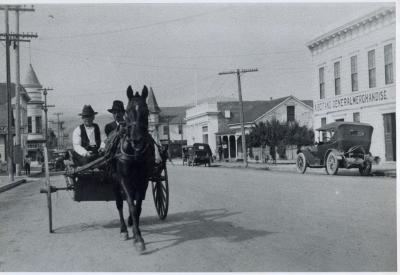
A month or so later, the then 47-year-old R.I. Knapp started all over again, moving his side-hill plow business into a new building on Main Street in Half Moon Bay. He said he was ready to take new orders.
Honors showered upon R.I. Knapp, the Coastside’s famous inventor, the man responsible for a new business that employed members of several families in town. San Francisco’s prestigious Mechanic’s Institute awarded him their silver-and-bronze medal. Knapp won further distinction by representing Half Moon Bay at the World Exposition held in New Orleans in 1885.
But there was a danger in the success of his Side-Hill Plow. Knapp’s patents were running out, and there were rumors that the big name farm equipment makers such as John Deere and South Bend Chilled Plow Company had been working on an identical plow design.
By the time Knapp’s son, Horace, had joined the enterprise, things had come a long way. The company produced a glossy catalogue offering an array of plows for different types of terrain. “Graders Pride No. 4” was used to cut grades for the Coastside’s Ocean Shore Railroad and the “Hula Queen Reversible Plow” was designed to till the fields in the Hawaiian Islands.
Predictably, R. I. ‘s plow patents began to run out and manufacturers such as John Deere rushed to copy them, selling the identical machinery at lower prices.
Three years after the 71-year-old Robert Knapp passed away in Half Moon Bay in 1904 , his heirs moved the plow factory to San Jose where the fruit orchard business promised a new need for agricultural equipment. Feeling over-confident, Knapp’s son, Horace, prepared for business demand on a grand scale. He constructed an expensive new factory and built the first orchard tractor. But he was unable to compete with the companies that could produce the same farming equipment faster and cheaper, and the inventive Knapp family closed their doors forever in the 1920s.
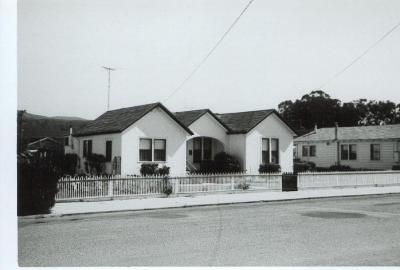 Photo: R.I. Knapp’s house on Johnston St., Half Moon Bay.
Photo: R.I. Knapp’s house on Johnston St., Half Moon Bay.
.
